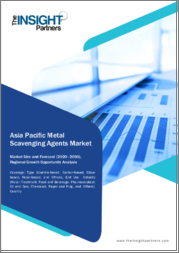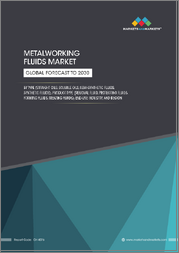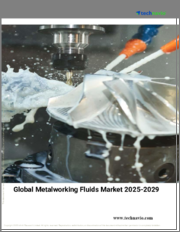
|
시장보고서
상품코드
1715216
아시아태평양의 금속 제거제 시장 예측(-2030년) - 지역별 분석(종류별, 최종 이용 산업별)Asia Pacific Metal Scavenging Agents Market Forecast to 2030 - Regional Analysis - by Type and End-Use Industry |
||||||
아시아태평양의 금속 제거제 시장은 2022년에 51억 9,164만 달러로 평가되며, 2030년에는 91억 2,633만 달러에 달할 것으로 예상되며, 2022년부터 2030년까지 7.3%의 CAGR을 기록할 것으로 예상됩니다.
수처리 플랜트에 대한 투자 증가로 아시아태평양의 금속 제거제 시장 성장 촉진
수처리 인프라에 대한 투자가 증가하고 있으며, 특히 물 부족과 오염 문제를 겪고 있는 신흥 경제국에서는 더욱 그러합니다. 이러한 투자 배경에는 깨끗하고 안전한 식수에 대한 접근성 부족 문제를 해결해야 할 시급한 필요성과 산업, 농업 및 도시 활동으로 인한 수질 오염에 대한 우려가 커지고 있습니다. 금속 제거제는 폐수 흐름에서 중금속을 제거하는 효과적인 솔루션을 제공하여 식수의 안전과 품질을 유지함으로써 이 시나리오에서 매우 중요한 역할을 하고 있습니다.
많은 신흥 경제국에서 산업화와 도시화로 인해 산업 폐수, 광산 활동, 부적절한 폐기물 처리, 농업 유출 등으로 인해 수원의 중금속 오염 수준이 증가하고 있습니다. 이러한 오염은 식수, 요리, 위생을 위해 수원에 의존하는 지역사회에 심각한 건강 위험을 초래하고 있습니다. 정부, 민간 기업 및 국제기구는 수질 오염 문제를 해결하기 위해 수처리 인프라에 대한 투자를 늘리고 있습니다.
킬레이트제, 이온교환수지, 흡착제 등의 금속 제거제는 오염된 물에서 중금속을 제거하기 위해 설계된 수처리 시스템의 필수적인 구성요소입니다. 이들 약제는 금속 이온과 효과적으로 결합하여 여과, 침전, 흡착 공정을 통해 제거할 수 있습니다. 금속 제거제를 수처리 공정에 통합하면 납, 수은, 비소, 카드뮴과 같은 오염 물질을 효율적으로 제거하여 처리된 물이 규제 기준을 충족하고 사람이 섭취하기에 안전하도록 보장할 수 있습니다.
정부와 상수도 사업자는 인프라 업그레이드 및 현대화 프로젝트에 대한 투자를 우선순위에 두고 있습니다. 따라서 수질을 개선하고 공중 보건을 보장하기 위해 금속 제거제를 포함한 혁신적인 수처리 솔루션에 대한 수요가 증가하고 있습니다. 신흥 경제국에서 금속 제거제에 대한 수요는 지속가능한 물 관리 방법의 중요성에 대한 인식이 높아지고 물 관련 문제를 해결하기 위한 첨단 기술 채택으로 인해 증폭되고 있습니다. 따라서 수처리 인프라에 대한 투자가 증가하고 있으며, 특히 물 부족과 오염 문제를 겪고 있는 신흥 경제국에서 수처리 인프라에 대한 투자가 증가하고 있으며, 이는 예측 기간 동안 아시아태평양의 금속 제거제 시장에 큰 기회를 제공할 것으로 예상됩니다.
아시아태평양의 금속 제거제 시장 개요
중국은 세계에서 가장 빠르게 성장하는 경제 중 하나입니다. 광업, 제조업, 제약, 화학, 수처리 등이 중국의 주요 산업입니다. 중국의 폭발적인 산업 성장으로 인해 많은 분야에서 상품 생산이 급증하고 있습니다. 인구 증가와 산업화는 중국의 수자원에 큰 부담을 주고 있습니다. 금속 제거제는 식수 및 산업 폐수처리에 중요한 역할을 하고 있습니다. 이 약제는 유해한 중금속을 효과적으로 제거하여 안전한 식수를 보장하고 산업 폐수로 인한 환경 영향을 최소화할 수 있습니다. 또한, 중국에서 중요한 위치를 차지하고 있는 전자 및 화학 산업에서는 고순도 재료가 요구되고 있습니다. 유럽화학공업협회에 따르면 2022년에는 2조 5,131억 달러에 달할 것으로 예상되며, 중국은 세계 최대의 화학 생산국입니다. 금속 불순물은 섬세한 제조 공정과 최종 제품의 특성을 저해할 수 있습니다. 금속 제거제는 이러한 산업이 요구하는 순도 수준을 달성하고 생산량과 제품 성능을 향상시킬 수 있도록 보장합니다.
아시아태평양의 금속 제거제 시장 수익 및 2030년까지 예측(금액)
아시아태평양의 금속 제거제 시장 세분화
아시아태평양 금속 포획제 시장은 유형, 최종 사용 산업, 국가별로 분류됩니다.
유형별로 아시아태평양의 금속 제거제 시장은 알루미나 기반, 탄소 기반, 실리카 기반, 수지 기반, 기타로 분류되며, 2022년 아시아태평양의 금속 제거제 시장 점유율은 기타 부문이 가장 큰 점유율을 차지했습니다.
최종 사용 산업별로 아시아태평양의 금속 제거제 시장은 수처리, 식음료, 제약, 석유 및 가스, 화학, 제지 및 펄프, 기타로 분류되며, 2022년 아시아태평양의 금속 제거제 시장 점유율은 제지 및 펄프 부문이 가장 큰 비중을 차지했습니다.
국가별로 아시아태평양의 금속 제거제 시장은 호주, 중국, 인도, 일본, 한국, 기타 아시아태평양으로 분류됩니다. 중국 부문은 2022년 아시아태평양의 금속 제거제 시장에서 가장 큰 점유율을 차지했습니다.
BASF SE, Biosynth AG, Biotage AB, Fuji Silysia Chemical Ltd, Johnson Matthey Plc, Merck KGaA, SiliCycle Inc, Supra Sciences Pvt Ltd, Vizag Chemicals Pvt Ltd는 아시아태평양의 금속 제거제 시장에서 활동하는 주요 기업입니다.
목차
제1장 소개
제2장 주요 요약
- 주요 인사이트
- 시장 매력
제3장 분석 방법
- 2차 조사
- 1차 조사
제4장 아시아태평양의 금속 제거제 시장 상황
- 개요
- Porter's Five Forces 분석
- 공급 기업의 교섭력
- 구매자의 교섭력
- 신규 참여업체의 위협
- 경쟁 기업 간의 경쟁 관계
- 대체품의 위협
- 생태계 분석
- 밸류체인 벤더 리스트
제5장 아시아태평양의 금속 제거제 시장 : 주요 시장 역학
- 아시아태평양의 금속 제거제 시장 : 주요 시장 역학
- 시장 성장 촉진요인
- 산업화와 도시화 진전
- 엄격한 환경 규제와 컴플라이언스
- 시장 성장 억제요인
- 높은 초기 투자, 전문 지식의 결여/이용 불가능성
- 시장 기회
- 수처리 플랜트에 대한 투자 증가
- 향후 동향
- 기술의 진보
- 영향 분석
제6장 금속 제거제 : 아시아태평양 시장 분석
- 아시아태평양의 금속 제거제 시장 규모(킬로톤)·매출(2022-2030년)
- 아시아태평양의 금속 제거제 시장 예측과 분석
제7장 아시아태평양의 금속 제거제 시장 분석 : 종류별
- 알루미나 기반
- 탄소 기반
- 실리카 기반
- 수지 기반
- 기타
제8장 아시아태평양의 금속 제거제 시장 분석 : 최종 이용 산업별
- 수처리
- 식품 및 음료
- 의약품
- 석유 및 가스
- 화학제품
- 제지·펄프
- 기타
제9장 아시아태평양의 금속 제거제 시장 : 국가별 분석
- 아시아태평양
- 호주
- 중국
- 인도
- 일본
- 한국
- 기타 아시아태평양
제10장 경쟁 구도
- 히트맵 분석 : 주요 기업별
- 기업 포지셔닝과 집중도
제11장 업계 상황
- 개요
- 인수합병
제12장 기업 개요
- BASF SE
- Biosynth AG
- Vizag Chemicals Pvt Ltd
- Fuji Silysia Chemical Ltd
- Merck KGaA
- Biotage AB
- Supra Sciences Pvt Ltd
- Johnson Matthey Plc
- SiliCycle Inc
제13장 기업 개요 부록
ksm 25.05.27Asia Pacific metal scavenging agents market was valued at US$ 5,191.64 million in 2022 and is expected to reach US$ 9,126.33 million by 2030; it is estimated to register a CAGR of 7.3% from 2022 to 2030.
Increasing Investments in Water Treatment Plants Boost Asia Pacific Metal Scavenging Agents Market
There are growing investments in water treatment infrastructure, especially in developing economies grappling with water scarcity and pollution issues. These investments are driven by the urgent need to address the challenges of inadequate access to clean and safe drinking water and the escalating concerns over water pollution caused by industrial, agricultural, and urban activities. Metal scavenging agents play a pivotal role in this scenario by offering effective solutions for removing heavy metals from wastewater streams, thereby maintaining the safety and quality of drinking water supplies.
In many developing economies, industrialization and urbanization have resulted in heightened levels of heavy metal contamination in water sources due to industrial effluents, mining activities, improper waste disposal, and agricultural runoff. The contamination poses significant health risks to communities reliant on these water sources for drinking, cooking, and sanitation purposes. Governments, private sector entities, and international organizations are increasing their investments in water treatment infrastructure to address the challenges of water contamination.
Metal scavenging agents, including chelating agents, ion exchange resins, and adsorbents, are integral components of water treatment systems designed to eliminate heavy metals from contaminated water. These agents effectively bind to metal ions, allowing for their removal through filtration, precipitation, or adsorption processes. By incorporating metal scavenging agents into water treatment processes, contaminants such as lead, mercury, arsenic, and cadmium can be efficiently removed, ensuring that treated water meets regulatory standards and is safe for human consumption.
Governments and water utilities prioritize investments in infrastructure upgrades and modernization projects. Thus, there is a heightened demand for innovative water treatment solutions, including metal scavenging agents, to improve water quality and ensure public health. The demand for metal scavenging agents in developing economies is amplified by the rising recognition of the importance of sustainable water management practices and the adoption of advanced technologies to address water-related challenges. Therefore, growing investments in water treatment infrastructure, especially in developing economies grappling with water scarcity and pollution issues, are expected to present substantial opportunities for the Asia Pacific metal scavenging agents market during the forecast period.
Asia Pacific Metal Scavenging Agents Market Overview
China is one of the fastest-growing economies in the world. Mining, manufacturing, pharmaceuticals, chemicals, and water treatment are among the major industries in the country. China's explosive industrial growth has led to an upsurge in the production of goods across many sectors. Population growth and industrialization place a significant strain on China's water resources. Metal scavenging agents play a critical role in the treatment of drinking water and industrial wastewater. These agents effectively remove harmful heavy metals, ensuring safe water for consumption and minimizing the environmental impact of industrial discharge. Furthermore, the electronics and chemical industries, significant in China, demand materials of exceptional purity. According to the European Chemical Industry Council, with US$ 2,513.1 billion in 2022, China is the largest chemical producer in the world. Metal impurities can interfere with delicate manufacturing processes or the properties of end products. Metal scavenging agents ensure these industries achieve the required purity levels, bolstering their output and product performance.
Asia Pacific Metal Scavenging Agents Market Revenue and Forecast to 2030 (US$ Million)
Asia Pacific Metal Scavenging Agents Market Segmentation
The Asia Pacific metal scavenging agents market is categorized into type, end-use industry, and country.
By type, the Asia Pacific metal scavenging agents market is segmented into alumina-based, carbon-based, silica-based, resin-based, and others. The others segment held the largest share of the Asia Pacific metal scavenging agents market share in 2022.
In terms of end-use industry, the Asia Pacific metal scavenging agents market is segmented into water treatment, food & beverages, pharmaceutical, oil & gas, chemicals, paper & pulp, and others. The paper & pulp segment held the largest share of the Asia Pacific metal scavenging agents market share in 2022.
Based on country, the Asia Pacific metal scavenging agents market is segmented into Australia, China, India, Japan, South Korea, and the Rest of Asia Pacific. China segment held the largest share of Asia Pacific metal scavenging agents market in 2022.
BASF SE, Biosynth AG, Biotage AB, Fuji Silysia Chemical Ltd, Johnson Matthey Plc, Merck KGaA, SiliCycle Inc, Supra Sciences Pvt Ltd, and Vizag Chemicals Pvt Ltd are some of the leading companies operating in the Asia Pacific metal scavenging agents market.
Table Of Contents
1. Introduction
- 1.1 The Insight Partners Research Report Guidance
- 1.2 Market Segmentation
2. Executive Summary
- 2.1 Key Insights
- 2.2 Market Attractiveness
3. Research Methodology
- 3.1 Coverage
- 3.2 Secondary Research
- 3.3 Primary Research
4. Asia Pacific Metal Scavenging Agents Market Landscape
- 4.1 Overview
- 4.2 Porters Analysis
- 4.2.1 Bargaining Power of Suppliers
- 4.2.2 Bargaining Power of Buyers
- 4.2.1 Threat of New Entrants
- 4.2.2 Intensity of Competitive Rivalry
- 4.2.3 Threat of Substitutes
- 4.3 Ecosystem Analysis
- 4.3.1 List of Vendors in the Value Chain
5. Asia Pacific Metal Scavenging Agents Market - Key Market Dynamics
- 5.1 Asia Pacific Metal Scavenging Agents Market - Key Market Dynamics
- 5.2 Market Drivers
- 5.2.1 Growing Industrialization and Urbanization
- 5.2.2 Stringent Environmental Regulation and Compliance
- 5.3 Market Restraints
- 5.3.1 High Initial Investment and Lack/Unavailability of Expertise
- 5.4 Market Opportunities
- 5.4.1 Increasing Investments in Water Treatment Plants
- 5.5 Future Trends
- 5.5.1 Technological Advancements
- 5.6 Impact Analysis
6. Metal Scavenging Agents Market - Asia Pacific Market Analysis
- 6.1 Asia Pacific Metal Scavenging Agents Market Volume (Kilo Tons), and Revenue (US$ Million), 2022-2030
- 6.2 Asia Pacific Metal Scavenging Agents Market Forecast Analysis
7. Asia Pacific Metal Scavenging Agents Market Analysis - By Type
- 7.1 Alumina-based
- 7.1.1 Overview
- 7.1.2 Alumina-based: Asia Pacific Metal Scavenging Agents Market - Volume, Revenue and Forecast to 2030 (Kilo Tons)
- 7.2 Carbon-based
- 7.2.1 Overview
- 7.2.2 Carbon-based: Asia Pacific Metal Scavenging Agents Market - Volume, Revenue and Forecast to 2030 (Kilo Tons)
- 7.3 Silica-based
- 7.3.1 Overview
- 7.3.2 Silica-based: Asia Pacific Metal Scavenging Agents Market - Volume, Revenue and Forecast to 2030 (Kilo Tons)
- 7.4 Resin-based
- 7.4.1 Overview
- 7.4.2 Resin-based: Asia Pacific Metal Scavenging Agents Market - Volume, Revenue and Forecast to 2030 (Kilo Tons)
- 7.5 Others
- 7.5.1 Overview
- 7.5.2 Others: Asia Pacific Metal Scavenging Agents Market - Volume, Revenue and Forecast to 2030 (Kilo Tons)
8. Asia Pacific Metal Scavenging Agents Market Analysis - By End Use Industry
- 8.1 Water Treatment
- 8.1.1 Overview
- 8.1.2 Water Treatment: Asia Pacific Metal Scavenging Agents Market - Revenue and Forecast to 2030 (US$ Million)
- 8.2 Food and Beverage
- 8.2.1 Overview
- 8.2.2 Food and Beverage: Asia Pacific Metal Scavenging Agents Market - Revenue and Forecast to 2030 (US$ Million)
- 8.3 Pharmaceutical
- 8.3.1 Overview
- 8.3.2 Pharmaceutical: Asia Pacific Metal Scavenging Agents Market - Revenue and Forecast to 2030 (US$ Million)
- 8.4 Oil and Gas
- 8.4.1 Overview
- 8.4.2 Oil and Gas: Asia Pacific Metal Scavenging Agents Market - Revenue and Forecast to 2030 (US$ Million)
- 8.5 Chemicals
- 8.5.1 Overview
- 8.5.2 Chemicals: Asia Pacific Metal Scavenging Agents Market - Revenue and Forecast to 2030 (US$ Million)
- 8.6 Paper and Pulp
- 8.6.1 Overview
- 8.6.2 Paper and Pulp: Asia Pacific Metal Scavenging Agents Market - Revenue and Forecast to 2030 (US$ Million)
- 8.7 Others
- 8.7.1 Overview
- 8.7.2 Others: Asia Pacific Metal Scavenging Agents Market - Revenue and Forecast to 2030 (US$ Million)
9. Asia Pacific Metal Scavenging Agents Market -Country Analysis
- 9.1 Asia Pacific
- 9.1.1 Asia Pacific: Metal Scavenging Agents Market - Revenue and Forecast Analysis - by Country
- 9.1.1.1 Asia Pacific: Metal Scavenging Agents Market - Volume, Revenue and Forecast Analysis - by Country
- 9.1.1.2 Australia: Metal Scavenging Agents Market - Volume, Revenue and Forecast to 2030 (Kilo Tons)
- 9.1.1.2.1 Australia: Metal Scavenging Agents Market Breakdown, by Type
- 9.1.1.2.2 Australia: Metal Scavenging Agents Market Breakdown, by End Use Industry
- 9.1.1.3 China: Metal Scavenging Agents Market - Volume, Revenue and Forecast to 2030 (Kilo Tons)
- 9.1.1.3.1 China: Metal Scavenging Agents Market Breakdown, by Type
- 9.1.1.3.2 China: Metal Scavenging Agents Market Breakdown, by End Use Industry
- 9.1.1.4 India: Metal Scavenging Agents Market - Volume, Revenue and Forecast to 2030 (Kilo Tons)
- 9.1.1.4.1 India: Metal Scavenging Agents Market Breakdown, by Type
- 9.1.1.4.2 India: Metal Scavenging Agents Market Breakdown, by End Use Industry
- 9.1.1.5 Japan: Metal Scavenging Agents Market - Volume, Revenue and Forecast to 2030 (Kilo Tons)
- 9.1.1.5.1 Japan: Metal Scavenging Agents Market Breakdown, by Type
- 9.1.1.5.2 Japan: Metal Scavenging Agents Market Breakdown, by End Use Industry
- 9.1.1.6 South Korea: Metal Scavenging Agents Market - Volume, Revenue and Forecast to 2030 (Kilo Tons)
- 9.1.1.6.1 South Korea: Metal Scavenging Agents Market Breakdown, by Type
- 9.1.1.6.2 South Korea: Metal Scavenging Agents Market Breakdown, by End Use Industry
- 9.1.1.7 Rest of Asia Pacific: Metal Scavenging Agents Market - Volume, Revenue and Forecast to 2030 (Kilo Tons)
- 9.1.1.7.1 Rest of Asia Pacific: Metal Scavenging Agents Market Breakdown, by Type
- 9.1.1.7.2 Rest of Asia Pacific: Metal Scavenging Agents Market Breakdown, by End Use Industry
- 9.1.1 Asia Pacific: Metal Scavenging Agents Market - Revenue and Forecast Analysis - by Country
10. Competitive Landscape
- 10.1 Heat Map Analysis by Key Players
- 10.2 Company Positioning & Concentration
11. Industry Landscape
- 11.1 Overview
- 11.2 Merger and Acquisition
12. Company Profiles
- 12.1 BASF SE
- 12.1.1 Key Facts
- 12.1.2 Business Description
- 12.1.3 Products and Services
- 12.1.4 Financial Overview
- 12.1.5 SWOT Analysis
- 12.1.6 Key Developments
- 12.2 Biosynth AG
- 12.2.1 Key Facts
- 12.2.2 Business Description
- 12.2.3 Products and Services
- 12.2.4 Financial Overview
- 12.2.5 SWOT Analysis
- 12.2.6 Key Developments
- 12.3 Vizag Chemicals Pvt Ltd
- 12.3.1 Key Facts
- 12.3.2 Business Description
- 12.3.3 Products and Services
- 12.3.4 Financial Overview
- 12.3.5 SWOT Analysis
- 12.3.6 Key Developments
- 12.4 Fuji Silysia Chemical Ltd
- 12.4.1 Key Facts
- 12.4.2 Business Description
- 12.4.3 Products and Services
- 12.4.4 Financial Overview
- 12.4.5 SWOT Analysis
- 12.4.6 Key Developments
- 12.5 Merck KGaA
- 12.5.1 Key Facts
- 12.5.2 Business Description
- 12.5.3 Products and Services
- 12.5.4 Financial Overview
- 12.5.5 SWOT Analysis
- 12.5.6 Key Developments
- 12.6 Biotage AB
- 12.6.1 Key Facts
- 12.6.2 Business Description
- 12.6.3 Products and Services
- 12.6.4 Financial Overview
- 12.6.5 SWOT Analysis
- 12.6.6 Key Developments
- 12.7 Supra Sciences Pvt Ltd
- 12.7.1 Key Facts
- 12.7.2 Business Description
- 12.7.3 Products and Services
- 12.7.4 Financial Overview
- 12.7.5 SWOT Analysis
- 12.7.6 Key Developments
- 12.8 Johnson Matthey Plc
- 12.8.1 Key Facts
- 12.8.2 Business Description
- 12.8.3 Products and Services
- 12.8.4 Financial Overview
- 12.8.5 SWOT Analysis
- 12.8.6 Key Developments
- 12.9 SiliCycle Inc
- 12.9.1 Key Facts
- 12.9.2 Business Description
- 12.9.3 Products and Services
- 12.9.4 Financial Overview
- 12.9.5 SWOT Analysis
- 12.9.6 Key Developments
13. Appendix
- 13.1 About The Insight Partners



















